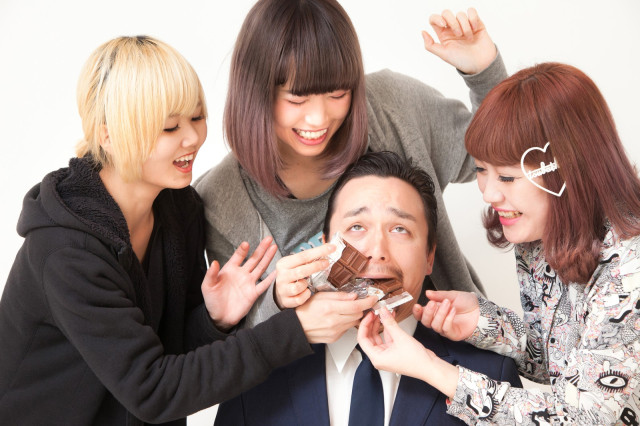In the geisha society, women run every thing, for instance they train and prepare the brand new Geisha, they arrange the enterprise to the Geisha as the position of okasan (mother) in the Geisha home.[38][39] Without the impeccable business abilities of the feminine tea homeowners, the world of geisha would stop to exist. The tea house owners are entrepreneurs, whose service to the geisha is very essential for the society to run smoothly. Infrequently, men take contingent positions similar to hair stylists,[40] dressers (dressing a maiko requires appreciable energy) and accountants,[sixteen] but men have a limited role in geisha society. There are a number of theories explaining women’s low workforce participation. One factors to the importance of family in Japanese society.[thirteen][14] This emphasis on the male-breadwinner mannequin persists as a result of authorities tax policies and firm benefits are not as beneficial for ladies, particularly women with households.
Amaya Booker. Archived from the unique on 30 July 2013. The institution of marriage in Japan has modified radically during the last millennium.
It is finished partly as a result of uncoloured tooth can appear very yellow in contrast to the oshiroi worn by maiko; from a distance, the tooth appear to disappear. By 1800, being a geisha was understood to be a feminine occupation (though a handful of male geisha still work today). Whilst licensed courtesans existed to fulfill the sexual wants of men, machi geisha (town geisha) started to carve out a separate niche as artists and erudite, worldly feminine companions. The introduction of various edicts on dress within the 1720s onwards, coupled with the rise of iki saw geisha take pleasure in a rise in popularity.
Polygamy defined
“Christian Polygamy In Chad Africa”. japanese girl Christian Polygamy Society.
“World’s oldest geisha appears to future to protect past”. AsiaOne. three December 2007.
United Nations Human Rights Website. Archived from the unique on 30 June 2013. Osborn, Andrew (14 January 2006). “War-ravaged Chechnya needs polygamy, says its leader”.
The scarlet-fringed collar of a maiko’s kimono hangs very loosely within the back to intensify the nape of the neck, which is considered a main erotic area in Japanese sexuality. She wears the identical white make-up for her face on her nape, leaving two or generally three stripes of naked pores and skin exposed. Her kimono is brilliant and colourful with an elaborately tied obi hanging all the way down to her ankles. She takes very small steps and wears conventional picket sneakers referred to as okobo which stand almost ten centimeters excessive.[6] There are five totally different hairstyles that a maiko wears, that mark the different levels of her apprenticeship. The “Nihongami” hairstyle with “kanzashi” hair-ornamentation strips is most closely associated with maiko,[30] who spend hours every week at the hairdresser and sleep on holed-pillows to protect the frilly styling.[31] Maiko can develop a bald spot on their crown brought on by rubbing from Kanzashi strips and tugging in hairdressing.
Multiple divorce and marriage for polygamy
While Japanese women’s standing has improved in the final a long time, traditional expectations for married women and moms are cited as a barrier to full financial equality.[6] The monarchy is strictly males-solely and a princess has to surrender her royal status when she marries a commoner. The practice of informal polygamy among fundamentalist teams presents several authorized points. It has been thought-about troublesome to prosecute polygamists for bigamy, largely as a result of they are rarely formally married beneath state legal guidelines.
Fewer marriages
Dorda, Cristina. “Geigi Gakko” (in Spanish).
Gender Inequality Index

Of the 15,442 non-Japanese brides in 2013, most came from China (40.4%), adopted by the Philippines (20.1%), South Korea (17.7%), and Thailand (6.3%). The 6,046 grooms got here from Korea (27.9%), the United States (19.1%), China (eleven.eight%), and Brazil (4.7%).[72] Many of the Chinese and Korean (Zainichi) nationals included in these statistics have lived in Japan for generations without becoming naturalized residents. Women in Japan obtained the right to vote in 1947.
Though regarded as pattern-setting, modern women on the peak of the occupation, this popularity was usurped in the late 18th and all through the nineteenth century by geisha, who were seen as freer, extra worldly, and simpler to work together with.[three] The career continued to say no steadily all through the 19th century, before prostitution was outlawed in Japan in 1957. Maiko sleep with their necks on small helps (takamakura), as a substitute of pillows, so they hold their coiffure good.[40] Even if there are not any accidents, a maiko will want her hair styled each week. Many modern geisha use wigs of their skilled lives, whereas maiko use their natural hair.[88] Either must be frequently tended by highly skilled artisans.
The parade, which takes place under the Spring cherry blossoms, historically re-enacts the walk made by high courtesans around their district in honour of their friends. The trendy parade features three oiran in full conventional attire with approximately 70 accompanying servants. The oiran, who’re named Shinano, Sakura, and Bunsui, have a slow distinctive gait because they put on 15 cm (5.9 in) high picket sandals. Due to the event’s recognition in Japan, organizers are inundated with functions to be one of many three oiran or a servant.
and sure by strict rules of ettiquette and behavior, the profession grew to become steadily more traditional, ritualised and faraway from popular society. This, alongside the excessive price of courting and oiran and the inaccessibility they posed, led to the profession’s decline between the 18th and 19th centuries, finally leading to its complete fall from favour and outlaw in 1957.
Archived from the original on 25 May 2007. “Inside Japan”. Hanami Web. Archived from the original on 24 February 2015. “Tokyo Asakusa” (in Japanese).
